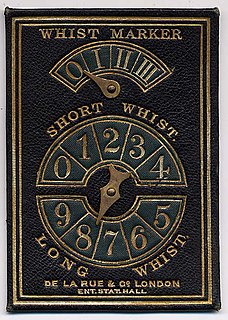
Proteobacteria is a major phylum of Gram-negative bacteria. They include a wide variety of pathogenic genera, such as Escherichia, Salmonella, Vibrio, Helicobacter, Yersinia, Legionellales, and many others. Others are free-living (nonparasitic) and include many of the bacteria responsible for nitrogen fixation.

Whist is a classic English trick-taking card game which was widely played in the 18th and 19th centuries. Although the rules are simple, there is scope for strategic play.

Jeet Kune Do is a hybrid martial art heavily influenced and adapted by the personal philosophy and experiences of martial artist Bruce Lee.

An exact sequence is a sequence of morphisms between objects such that the image of one morphism equals the kernel of the next.
In astrophysics, silicon burning is a very brief sequence of nuclear fusion reactions that occur in massive stars with a minimum of about 8–11 solar masses. Silicon burning is the final stage of fusion for massive stars that have run out of the fuels that power them for their long lives in the main sequence on the Hertzsprung–Russell diagram. It follows the previous stages of hydrogen, helium, carbon, neon and oxygen burning processes.
Medical ethics is an applied branch of ethics which analyzes the practice of clinical medicine and related scientific research. Medical ethics is based on a set of values that professionals can refer to in the case of any confusion or conflict. These values include the respect for autonomy, non-maleficence, beneficence, and justice. Such tenets may allow doctors, care providers, and families to create a treatment plan and work towards the same common goal. It is important to note that these four values are not ranked in order of importance or relevance and that they all encompass values pertaining to medical ethics. However, a conflict may arise leading to the need for hierarchy in an ethical system, such that some moral elements overrule others with the purpose of applying the best moral judgement to a difficult medical situation. Medical ethics is particularly relevant in decisions regarding involuntary treatment and involuntary commitment.

The Progressive utilization theory (PROUT) is a socioeconomic and political theory created by the Indian philosopher and spiritual leader Prabhat Ranjan Sarkar. He first conceived of PROUT in 1959. Its proponents (Proutists) claim that the theory exposes and overcomes the limitations of both capitalism and communism. Since its genesis, PROUT has had an economically progressive approach, aiming improve social development in the world. The theory is in line with Sarkar's Neohumanist values which aim to provide "proper care" to every being on the planet, including humans, animals and plants.
Yoga nidra or yogic sleep is a state of consciousness between waking and sleeping, like the "going-to-sleep" stage (hypnagogia), typically induced by a guided meditation.

Charles Frazier Stanley is Pastor Emeritus of First Baptist Church in Atlanta, Georgia, after serving as senior pastor for 51 years. He is the founder and president of In Touch Ministries, which widely broadcasts his sermons through television. He also served two one-year terms as president of the Southern Baptist Convention, from 1984 to 1986.
Character animation is a specialized area of the animation process, which involves bringing animated characters to life. The role of a character animator is analogous to that of a film or stage actor and character animators are often said to be "actors with a pencil". Character animators breathe life in their characters, creating the illusion of thought, emotion and personality. Character animation is often distinguished from creature animation, which involves bringing photorealistic animals and creatures to life.

The Bagua or Pakua was originated in China, and it consists of eight symbols used in Taoist cosmology to represent the fundamental principles of reality, seen as a range of eight interrelated concepts. Each consists of three lines, each line either "broken" or "unbroken", respectively representing yin or yang, 0 or 1 forming binary numbers 000-111. Due to their tripartite structure, they are often referred to as Eight Trigrams in English.
A lesson plan is a teacher's detailed description of the course of instruction or "learning trajectory" for a lesson. A daily lesson plan is developed by a teacher to guide class learning. Details will vary depending on the preference of the teacher, subject being covered, and the needs of the students. There may be requirements mandated by the school system regarding the plan. A lesson plan is the teacher's guide for running a particular lesson, and it includes the goal, how the goal will be reached and a way of measuring how well the goal was reached.

The 91st Indianapolis 500 was held at the Indianapolis Motor Speedway in Speedway, Indiana on Sunday May 27, 2007. It was the twelfth Indy 500 sanctioned by the Indy Racing League, and marked the fifth race of the 2007 IndyCar Series season. Hélio Castroneves started the race on the pole position.
Learning standards are elements of declarative, procedural, schematic, and strategic knowledge that, as a body, define the specific content of an educational program. Standards are usually composed of statements that express what a student knows, can do, or is capable of performing at a certain point in their '''learning progression'''.
Exposure therapy is a technique in behavior therapy to treat anxiety disorders. Exposure therapy involves exposing the target patient to the anxiety source or its context without the intention to cause any danger. Doing so is thought to help them overcome their anxiety or distress. Procedurally, it is similar to the fear extinction paradigm developed for studying laboratory rodents. Numerous studies have demonstrated its effectiveness in the treatment of disorders such as generalized anxiety disorder, social anxiety disorder, obsessive-compulsive disorder, post-traumatic stress disorder (PTSD), and specific phobias.

Disney's twelve basic principles of animation were introduced by the Disney animators Ollie Johnston and Frank Thomas in their 1981 book The Illusion of Life: Disney Animation. The principles are based on the work of Disney animators from the 1930s onwards, in their quest to produce more realistic animations. The main purpose of these principles was to produce an illusion that cartoon characters adhered to the basic laws of physics, but they also dealt with more abstract issues, such as emotional timing and character appeal.
Lean enterprise is a practice focused on value creation for the end customer with minimal waste and processes. The term has historically been associated with lean manufacturing and Six Sigma due to lean principles being popularized by Toyota in the automobile manufacturing industry and subsequently the electronics and internet software industries.
Jaimini Sutras, also called as Upadesa Sutras is an ancient Sanskrit text on the predictive part of Hindu astrology, attributed to Maharishi Jaimini, the founder of the Purva Mimamsa branch of Hindu philosophy, a disciple of Rishi Vyasa and grandson of Parashara. It comprises nine hundred and thirty-six sutras or aphorisms arranged in four chapters, and though having several distinct features of its own, the Jaimini System, which is a unique system, appears as an offshoot of the Parashari System only; wherever it deviates, it is not found to be in conflict with the Parashari system, and gives due importance to Rahu and Ketu, the two Lunar Nodes.
The Federation of Enterprise Architecture Professional Organizations (FEAPO) is a worldwide association of professional organizations, aiming to standardize, professionalize, and otherwise advance the discipline of enterprise architecture." Brian Cameron is the founding director."
Sequence-defined polymer is a uniform macromolecule with an exact chain-length and a perfectly defined sequence of monomers. In other words, each monomer unit is at a defined position in the chain e.g. peptides, proteins, oligonucleotides. Sequence-defined polymers constitute therefore a subclass of the field of sequence-controlled polymers.








